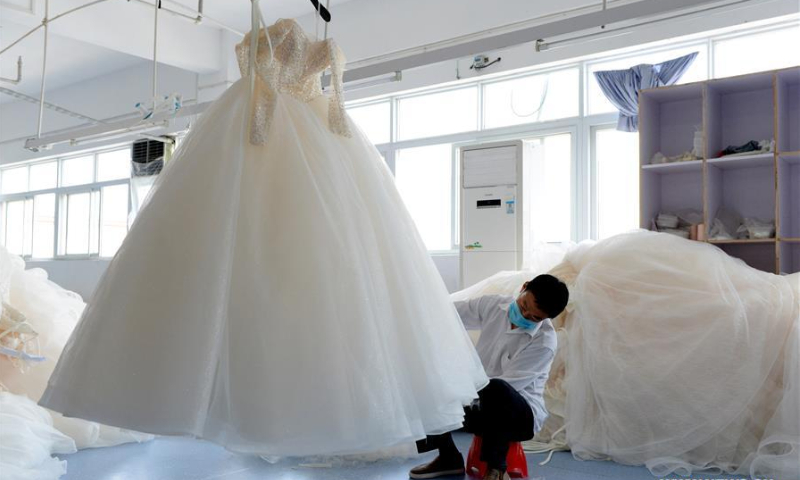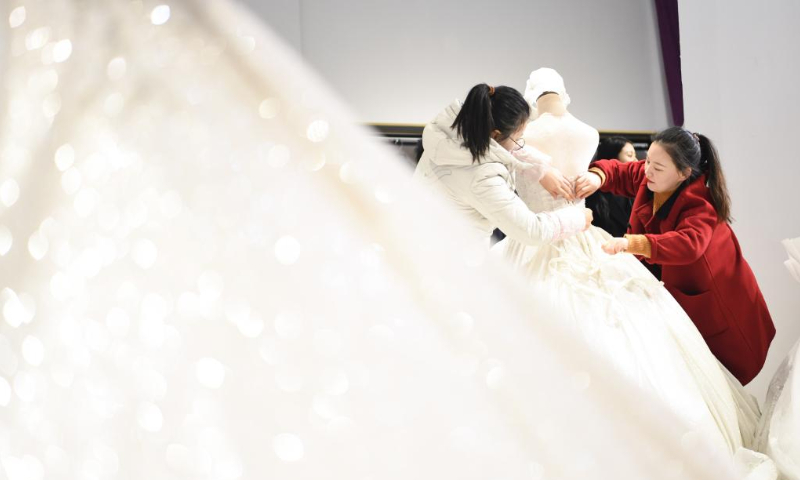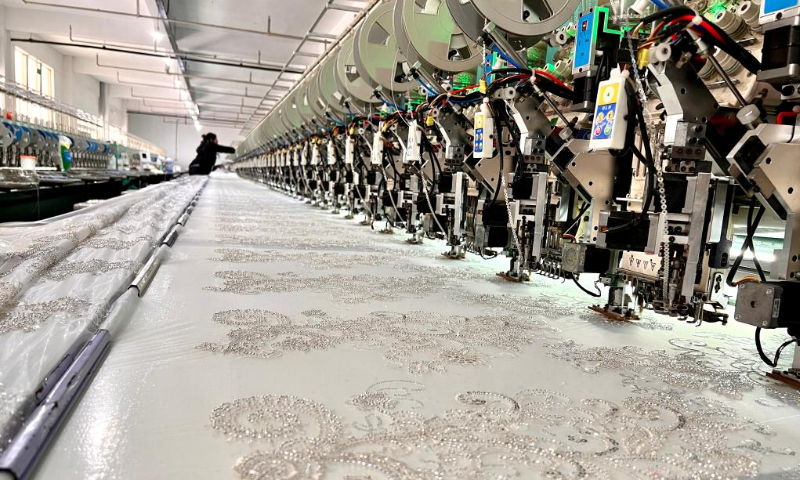
A worker trims wedding dress hemlines at a wedding dress producing company in Dingji Town of Lu'an City, East China's Anhui Province. Photo: Xinhua
Threading, leading, beading, winding... Sparkling beads and sequins form flower patterns on white wedding dresses by computerized embroidery machines.
After six or seven complex procedures, a piece of complex and exquisite wedding dress is completed, which will be exported and dress up millions of brides around the world.
This is a daily scene in factories of more than 600 wedding dress enterprises in Dingji town, East China's Anhui Province. The small town, with a permanent population of 33,992, has more than 15,000 wedding dress producers. It has become one of the largest wedding dress manufacturing and sales hubs in China. The market is expected to rebound significantly in 2023 as enterprises fire on all cylinders to meet deadlines.
Jiang Houhui's factory in Dingji is among those working in full swing to make wedding dresses for piling orders from home and abroad.
"Our factory is currently under-staffed and working overtime into the early hours of the morning to meet market demand. We can produce about 100 wedding dresses and 300 formal dresses per month," Jiang, general manager of Jinhuiyuan Wedding Dress Co, told the Global Times in a recent interview.
Booming industryAbout 30 percent of the wedding dresses and formal dresses are exported to Europe, America, Australia and other regions by exporters in South China's Guangdong Province, said Jiang.
An employee surnamed Yang of the New Era Wedding Dress Co told the Global Times that their wedding dresses are mainly sold to the US and European markets.
In 2022, nearly 5 million wedding dresses were exported to more than 50 countries and regions from Dingji, averaging 13,000 wedding dresses per day, aided by a logistics system on par with those in big Chinese cities, according to statistics from Dingji township.
The wedding dress industry in Dingji created an annual output value of 2.4 billion yuan ($350 million).
Statistics show that China is the world's largest exporter of wedding dresses as nearly 90 percent of the world's wedding dresses are produced in China.

A shop owner arranges wedding dresses in a shop in Dingji township, Lu'an city, East China's Anhui Province. Photo: Xinhua
Dingji wedding dress manufacturing began to boom more than a decade ago. Many Dingji natives who used to work in Huqiu, another major wedding dress manufacturing base in Suzhou city, East China's Jiangsu Province, have returned to their hometown to start their own businesses, attracted by preferential local policies.
The general manager of YBeiZ Wedding Dress Co is among the Dingji natives who came back to the small town after having gained experience in Huqiu.
"Dingji town has now formed a large-scale industrial cluster with a whole industrial chain covering design, embroidery, sewing and customization of wedding dresses," said the manager.
He noted that the support of e-commerce boosted sales of wedding dress. About 80 percent of local companies sell through e-commerce platforms. "E-commerce can get to more people, so geographical location is no longer a barrier for landlocked places like Dingji," he said.
He revealed that local factories generally do not produce stitches and cloth, which are provided by manufacturers in nearby towns.
In order to better develop the wedding dress industry and create a brand of its own, Dingji has planned to build a "wedding dress town" covering an area of 3.15 square kilometers, bringing together the production and marketing of wedding dresses, wedding photography and wedding exhibitions.
The first phase of the "wedding dress town" has already attracted about 220 stores, including Jiang's shop.
Upgraded techniquesIn response to the fluxing market, manufacturers are constantly trying to keep up with the latest fashion trends, leveraging upgraded knitting techniques.
Traditional Chinese red wedding dresses, which have become popular in China in recent years, are displayed side by side with Western-style white wedding dresses.
"Whether in domestic or overseas markets, designs with traditional Chinese elements, such as mandarin collar and embroidery, are increasingly popular," said Yang of the New Era Wedding Dress Co.
The wedding dress carrying people's good wishes has become more and more diversified so that manufacturers pay more attention to focus on fashion and cultural elements. The price of wedding dresses has also risen as consumer requirements have become increasingly sophisticated.
"The whole wedding dress production is complicated, so the price is relatively high. The cheapest dress costs more than 1,000 yuan," said Jiang.

Computerized embroidery machines run in a wedding dress factory in Dingji township, Yu'an district, Lu'an city, East China's Anhui Province. Photo: Xinhua
Yang said that currently, most of the factories in Dingji village use computerized embroidery machines to make wedding dresses. According to Yang, they have computerized embroidery machines with a total length of about 15 meters, which allow 48 needles beat rapidly at the same time.
"For example, some of the flower pattern requires more than 80,000 stitches. When the pattern is computerized, the machine automatically starts working. It's very efficient," Yang said, with a big smile.






